Highly Enhancing the Interfacial and Mechanical Properties of Basalt Fiber/Poly(phthalazinone ether nitrile ketone) Composite by Thermoplastic Sizing Agents with Different Structures
Abstract
:1. Introduction
2. Materials and Experiments
2.1. Materials
2.2. Synthesis of the TP Sizing Agents
2.3. Preparation of Composites
2.4. Characterization
3. Results and Discussion
3.1. Compatibility of Polymer Sizing Agents and PPENK Matrix
3.2. The Surface Morphology and Elements of BFs
3.3. Interfacial Properties
3.4. Tensile Properties
3.5. Tensile Failure Mechanism
3.6. Compressive Properties
3.7. Compressive Failure Mechanism
3.8. Flexural Strength and ILSS
4. Conclusions
Supplementary Materials
Author Contributions
Funding
Institutional Review Board Statement
Informed Consent Statement
Data Availability Statement
Conflicts of Interest
References
- Xu, J.; Xia, L.; Luo, J.; Lu, S.; Huang, X.; Zhong, B.; Zhang, T.; Wen, G.; Wu, X.; Xiong, L.; et al. High-Performance Electromagnetic Wave Absorbing CNT/SiCf Composites: Synthesis, Tuning, and Mechanism. ACS Appl. Mater. Interfaces 2020, 12, 20775–20784. [Google Scholar] [CrossRef] [PubMed]
- Gao, S.-l.; Zhuang, R.-C.; Zhang, J.; Liu, J.-W.; Mäder, E. Glass Fibers with Carbon Nanotube Networks as Multifunctional Sensors. Adv. Funct. Mater. 2010, 20, 1885–1893. [Google Scholar] [CrossRef]
- Lin, F.; Du, X.; Li, W.; Jiang, J.; Chen, N. Interfacial properties of high failure strain polyimide fiber/epoxy composites analyzed by a modified single fiber fragmentation test. Appl. Surf. Sci. 2020, 513, 145869. [Google Scholar] [CrossRef]
- Li, C.; Shi, Y.; Zhang, R.; Wang, G.; Jia, J. Effect of surface modifications on the properties of UHMWPE fibres and their composites. e-Polymers 2019, 19, 40–49. [Google Scholar] [CrossRef]
- Ramezanianpour, A.A.; Esmaeili, M.; Ghahari, S.A.; Najafi, M.H. Laboratory study on the effect of polypropylene fiber on durability, and physical and mechanical characteristic of concrete for application in sleepers. Constr. Build. Mater. 2013, 44, 411–418. [Google Scholar] [CrossRef]
- Bulut, M.; Bozkurt, O.Y.; Erklig, A.; Yaykasli, H.; Ozbek, O. Mechanical and Dynamic Properties of Basalt Fiber-Reinforced Composites with Nanoclay Particles. Arab. J. Sci. Eng. 2020, 45, 1017–1033. [Google Scholar] [CrossRef]
- Kizilkanat, A.B.; Kabay, N.; Akyüncü, V.; Chowdhury, S.; Akça, A.H. Mechanical properties and fracture behavior of basalt and glass fiber reinforced concrete: An experimental study. Constr. Build. Mater. 2015, 100, 218–224. [Google Scholar] [CrossRef]
- Jayasuriya, S.; Chegeni, B.; Das, S. Use of BFRP wrap for rehabilitation of pipeline in bending with various corrosion depths. J. Pipeline Syst. Eng. Pract. 2020, 11, 04019038. [Google Scholar] [CrossRef]
- Zhang, M.; Denning, R.; Zhong, Z.; Wang, X.; Shen, Y.; Naebe, M. Investigation of heat transfer properties of plasma-treated and silicone-elastomer coated basalt fabric. Coatings 2019, 9, 292. [Google Scholar] [CrossRef] [Green Version]
- Monaldo, E.; Nerilli, F.; Vairo, G. Basalt-based fiber-reinforced materials and structural applications in civil engineering. Compos. Struct. 2019, 214, 246–263. [Google Scholar] [CrossRef]
- Hao, B.; Förster, T.; Mäder, E.; Ma, P. Modification of basalt fibre using pyrolytic carbon coating for sensing applications. Compos. Part A Appl. Sci. Manuf. 2017, 101, 123–128. [Google Scholar] [CrossRef]
- Simone, B.; Giuseppe, D.C.; Natalino, D.B.; Carosena, M.; Giovanni, M.C.; Ernesto, M.; Pietro, R.; Giorgio, S. Lock-in thermography and ultrasonic testing of impacted basalt fibers reinforced thermoplastic matrix composites. Appl. Sci. 2019, 9, 3025. [Google Scholar] [CrossRef] [Green Version]
- Kim, D.; Mittal, G.; Kim, M.; Kim, S.; Yop Rhee, K. Surface modification of MMT and its effect on fatigue and fracture behavior of basalt/epoxy based composites in a seawater environment. Appl. Surf. Sci. 2019, 473, 55–58. [Google Scholar] [CrossRef]
- Liu, S.; Wu, G.; Yu, J.; Chen, X.; Guo, J.; Zhang, X.; Wang, P.; Yin, X. Surface modification of basalt fiber (BF) for improving compatibilities between BF and poly lactic acid (PLA) matrix. Compos. Interfaces 2018, 26, 275–290. [Google Scholar] [CrossRef]
- Xie, J.-H.; Wei, M.-W.; Huang, P.-Y.; Zhang, H.; Chen, P.-S. Fatigue behavior of the basalt fiber-reinforced polymer/concrete interface under wet-dry cycling in a marine environment. Constr. Build. Mater. 2019, 228, 117065. [Google Scholar] [CrossRef]
- Khandelwal, S.; Rhee, K.Y. Recent advances in basalt-fiber-reinforced composites: Tailoring the fiber-matrix interface. Compos. Part B Eng. 2020, 192, 108011. [Google Scholar] [CrossRef]
- Guo, H.; Zhan, Y.; Chen, Z.; Meng, F.; Wei, J.; Liu, X. Decoration of basalt fibers with hybrid Fe3O4 microspheres and their microwave absorption application in bisphthalonitrile composites. J. Mater. Chem. A 2013, 1, 2286–2296. [Google Scholar] [CrossRef]
- Li, Z.; Wan, J.; Li, Y.; Li, Y.; Zhao, F.; Zhao, S. Effects of coupling agents on the properties of an NR/SBR matrix and its adhesion to continuous basalt fiber cords. J. Appl. Polym. Sci. 2018, 136, 47098. [Google Scholar] [CrossRef]
- Yang, W.; Zhang, Y.R.; Yuen, A.C.Y.; Chen, T.B.Y.; Chan, M.C.; Peng, L.Z.; Yang, W.J.; Zhu, S.E.; Yang, B.H.; Hu, K.H.; et al. Synthesis of phosphorus-containing silane coupling agent for surface modification of glass fibers: Effective reinforcement and flame retardancy in poly(1,4-butylene terephthalate). Chem. Eng. J. 2017, 321, 257–267. [Google Scholar] [CrossRef]
- Yuan, X.; Jiang, J.; Wei, H.; Yuan, C.; Wang, M.; Zhang, D.; Liu, L.; Huang, Y.; Gao, G.; Jiang, Z. PAI/MXene sizing-based dual functional coating for carbon fiber/PEEK composite. Compos. Sci. Technol. 2021, 201, 108496. [Google Scholar] [CrossRef]
- Xiang, Y.; Xie, Y.; Long, G. Effect of basalt fiber surface silane coupling agent coating on fiber-reinforced asphalt: From macro-mechanical performance to micro-interfacial mechanism. Constr. Build. Mater. 2018, 179, 107–116. [Google Scholar] [CrossRef]
- Zhang, S.; Liu, W.; Wang, J.; Li, B.; Hao, L.; Wang, R. Improvement of interfacial properties of carbon fiber-reinforced poly(phthalazinone ether ketone) composites by introducing carbon nanotube to the interphase. Polym. Compos. 2015, 36, 26–33. [Google Scholar] [CrossRef]
- Thomason, J.L.; Adzima, L.J. Sizing up the interphase: An insider’s guide to the science of sizing. Compos. Part A Appl. Sci. Manuf. 2001, 32, 313–321. [Google Scholar] [CrossRef]
- Dong, Y.; Zhu, Y.; Zhao, Y.; Liu, F.; Wang, E.; Fu, Y. Enhance interfacial properties of glass fiber/epoxy composites with environment-friendly water-based hybrid sizing agent. Compos. Part A Appl. Sci. Manuf. 2017, 102, 357–367. [Google Scholar] [CrossRef]
- Chen, Z.; Huang, Y. Preparation and performance of fumed silica-stabilized epoxy resin pickering emulsion for basalt fiber–sizing agents. Adv. Compos. Hybrid Mater. 2021, 4, 1205–1214. [Google Scholar] [CrossRef]
- Hassan, E.A.M.; Yang, L.; Elagib, T.H.H.; Ge, D.; Lv, X.; Zhou, J.; Yu, M.; Zhu, S. Synergistic effect of hydrogen bonding and π-π stacking in interface of CF/PEEK composites. Compos. Part B Eng. 2019, 171, 70–77. [Google Scholar] [CrossRef]
- Bowman, S.; Jiang, Q.; Memon, H.; Qiu, Y.; Liu, W.; Wei, Y. Effects of styrene-acrylic sizing on the mechanical properties of carbon fiber thermoplastic towpregs and their composites. Molecules 2018, 23, 547. [Google Scholar] [CrossRef] [Green Version]
- Giraud, I.; Franceschi, S.; Perez, E.; Lacabanne, C.; Dantras, E. Influence of new thermoplastic sizing agents on the mechanical behavior of poly(ether ketone ketone)/carbon fiber composites. J. Appl. Polym. Sci. 2015, 132, 1–5. [Google Scholar] [CrossRef] [Green Version]
- Liu, L.; Yan, F.; Li, M.; Zhang, M.; Xiao, L.; Shang, L.; Ao, Y. A novel thermoplastic sizing containing graphene oxide functionalized with structural analogs of matrix for improving interfacial adhesion of CF/PES composites. Compos. Part A Appl. Sci. Manuf. 2018, 114, 418–428. [Google Scholar] [CrossRef]
- Kodokian, G.K.A.; Kinloch, A.J. Surface pretreatment and adhesion of thermoplastic fibre-composites. J. Mater. Sci. Lett. 1988, 7, 625–627. [Google Scholar] [CrossRef]
- Zhu, S.; Qian, Y.; Hassan, E.A.M.; Shi, R.; Yang, L.; Cao, H.; Zhou, J.; Ge, D.; Yu, M. Enhanced interfacial interactions by PEEK-grafting and coupling of acylated CNT for GF/PEEK composites. Compos. Commun. 2020, 18, 43–48. [Google Scholar] [CrossRef]
- Wang, X.; Huang, Z.; Lai, M.; Jiang, L.; Zhang, Y.; Zhou, H. Highly enhancing the interfacial strength of CF/PEEK composites by introducing PAIK onto diazonium functionalized carbon fibers. Appl. Surf. Sci. 2020, 510, 145400. [Google Scholar] [CrossRef]
- Hassan, E.A.M.; Ge, D.; Yang, L.; Zhou, J.; Liu, M.; Yu, M.; Zhu, S. Highly boosting the interlaminar shear strength of CF/PEEK composites via introduction of PEKK onto activated CF. Compos. Part A Appl. Sci. Manuf. 2018, 112, 155–160. [Google Scholar] [CrossRef]
- Wang, T.; Jiao, Y.; Mi, Z.; Li, J.; Wang, D.; Zhao, X.; Zhou, H.; Chen, C. PEEK composites with polyimide sizing SCF as reinforcement: Preparation, characterization, and mechanical properties. High Perform. Polym. 2019, 32, 383–393. [Google Scholar] [CrossRef]
- Li, X.; Meng, Y.; Jian, X.; Hay, A. Synthesis and properties of copoly(ether ketone) containing hydroquinone and phthalazinone moieties. Polym. Mater. Sci. Eng. 1998, 14, 37–39. [Google Scholar] [CrossRef]
- Wang, M.; Liu, C.; Liu, Z.; Dong, L.; Jian, X. Synthesis and characterization of phthalazinone-containing poly (aryl ether nitrele ketone ketone)s. Acta Polym. Sin. 2007, 09, 833–837. [Google Scholar] [CrossRef]
- Kim, M.T.; Kim, M.H.; Rhee, K.Y.; Park, S.J. Study on an oxygen plasma treatment of a basalt fiber and its effect on the interlaminar fracture property of basalt/epoxy woven composites. Compos. Part B Eng. 2011, 42, 499–504. [Google Scholar] [CrossRef]
- Yu, S.; Oh, K.H.; Hwang, J.Y.; Hong, S.H. The effect of amino-silane coupling agents having different molecular structures on the mechanical properties of basalt fiber-reinforced polyamide 6,6 composites. Compos. Part B Eng. 2019, 163, 511–521. [Google Scholar] [CrossRef]
- Zhang, J.; Li, Y.; Xing, D.; Wang, Q.; Wang, H.; Koubaa, A. Reinforcement of continuous fibers for extruded wood-flour/HDPE composites: Effects of fiber type and amount. Constr. Build. Mater. 2019, 228, 116718. [Google Scholar] [CrossRef]
- Gangineni, P.K.; Yandrapu, S.; Ghosh, S.K.; Anand, A.; Prusty, R.K.; Ray, B.C. Mechanical behavior of Graphene decorated carbon fiber reinforced polymer composites: An assessment of the influence of functional groups. Compos. Part A Appl. Sci. Manuf. 2019, 122, 36–44. [Google Scholar] [CrossRef]
- Murayama, T.; Lawton, E.L. Dynamic loss energy measurement of tire cord adhesion to rubber. J. Appl. Polym. Sci. 1973, 17, 669–677. [Google Scholar] [CrossRef]
- Jia, H.; Liu, C.; Qiao, Y.; Zhang, Y.; Dang, X.; Chen, Y.; Jian, X. Enhanced interfacial and mechanical properties of basalt fiber reinforced poly(aryl ether nitrile ketone) composites by amino-silane coupling agents. Polymer 2021, 230, 124028. [Google Scholar] [CrossRef]
- Chauhan, S.; Karmarkar, A.; Aggarwal, P. Damping behavior of wood filled polypropylene composites. J. Appl. Polym. Sci. 2009, 114, 2421–2426. [Google Scholar] [CrossRef]
- Lopresto, V.; Leone, C.; De Iorio, I. Mechanical characterisation of basalt fibre reinforced plastic. Compos. Part B Eng. 2011, 42, 717–723. [Google Scholar] [CrossRef]
- Chairman, C.A.; Kumaresh Babu, S.P. Mechanical and abrasive wear behavior of glass and basalt fabric-reinforced epoxy composites. J. Appl. Polym. Sci. 2013, 130, 120–130. [Google Scholar] [CrossRef]
- Colombo, C.; Vergani, L.; Burman, M. Static and fatigue characterisation of new basalt fibre reinforced composites. Compos. Struct. 2012, 94, 1165–1174. [Google Scholar] [CrossRef]
- Varley, R.J.; Tian, W.; Leong, K.H.; Leong, A.Y.; Fredo, F.; Quaresimin, M. The effect of surface treatments on the mechanical properties of basalt-reinforced epoxy composites. Polym. Compos. 2013, 34, 320–329. [Google Scholar] [CrossRef]
- Wang, M.; Zhang, Z.; Li, Y.; Li, M.; Sun, Z. Chemical Durability and Mechanical Properties of Alkali-proof Basalt Fiber and its Reinforced Epoxy Composites. J. Reinf. Plast. Compos. 2008, 27, 393–407. [Google Scholar] [CrossRef]
- Williams, T.O.; Cairns, D.S. A model for the compressive failure of composite materials. J. Compos. Mater. 1994, 28, 92–111. [Google Scholar] [CrossRef]
- Narayanan, S.; Schadler, L.S. Mechanisms of kink-band formation in graphite/epoxy composites: A micromechanical experimental study. Compos. Sci. Technol. 1999, 59, 2201–2213. [Google Scholar] [CrossRef]
- De Carvalho, N.V.; Pinho, S.T.; Robinson, P. An experimental study of failure initiation and propagation in 2D woven composites under compression. Compos. Sci. Technol. 2011, 71, 1316–1325. [Google Scholar] [CrossRef] [Green Version]
- Madhukar, M.S.; Drzal, L.T. Fiber-matrix adhesion and its effect on composite mechanical properties. III. Longitudinal (0°) compressive properties of graphite/epoxy composites. J. Compos. Mater. 1992, 26, 310–333. [Google Scholar] [CrossRef]
- Bader, M.G.; Bailey, J.E.; Bell, I. The effect of fibre-matrix interface strength on the impact and fracture properties of carbon-fibre reinforced epoxy resin composites. J. Phys. D Appl. Phys. 1973, 6, 572–586. [Google Scholar] [CrossRef]

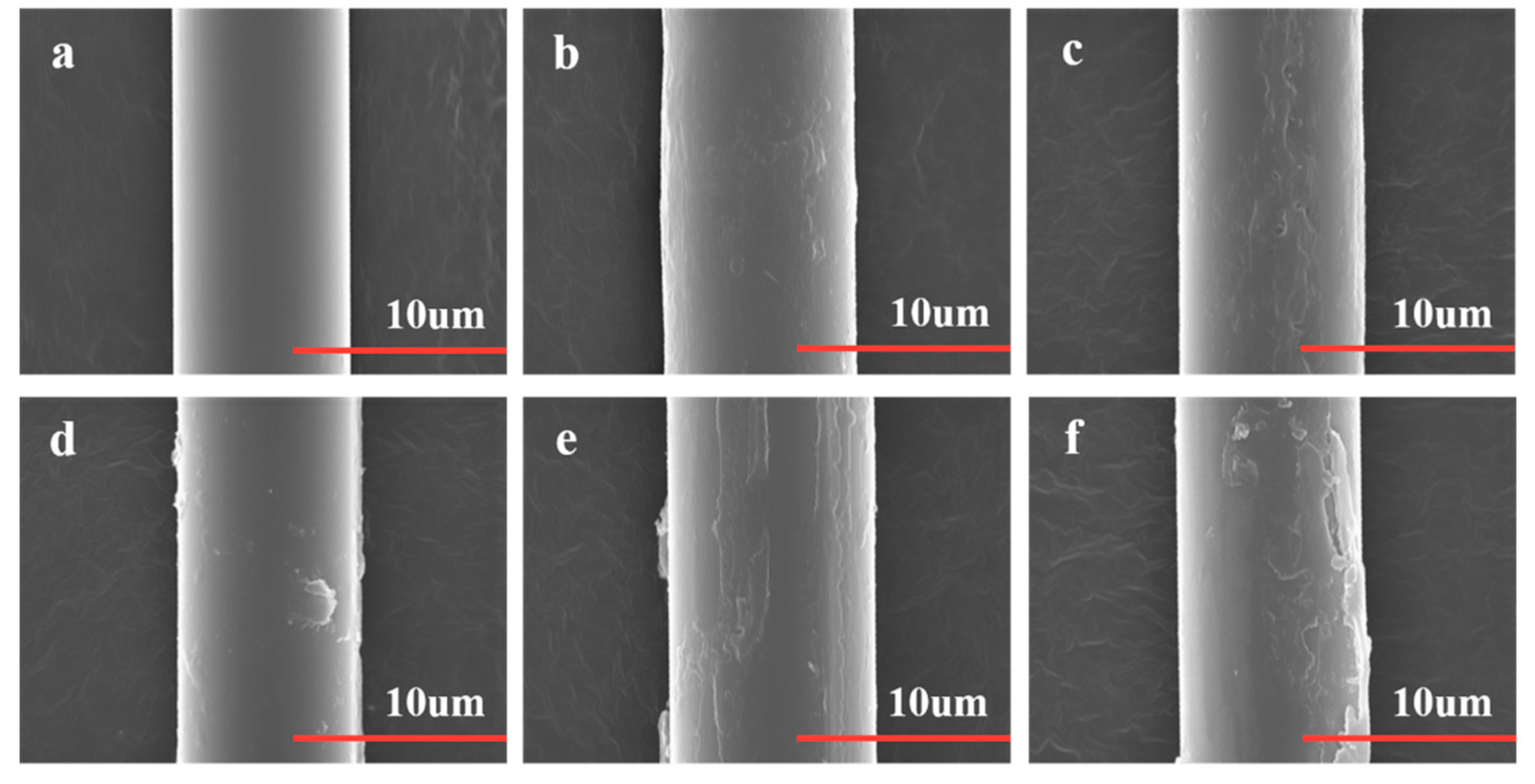
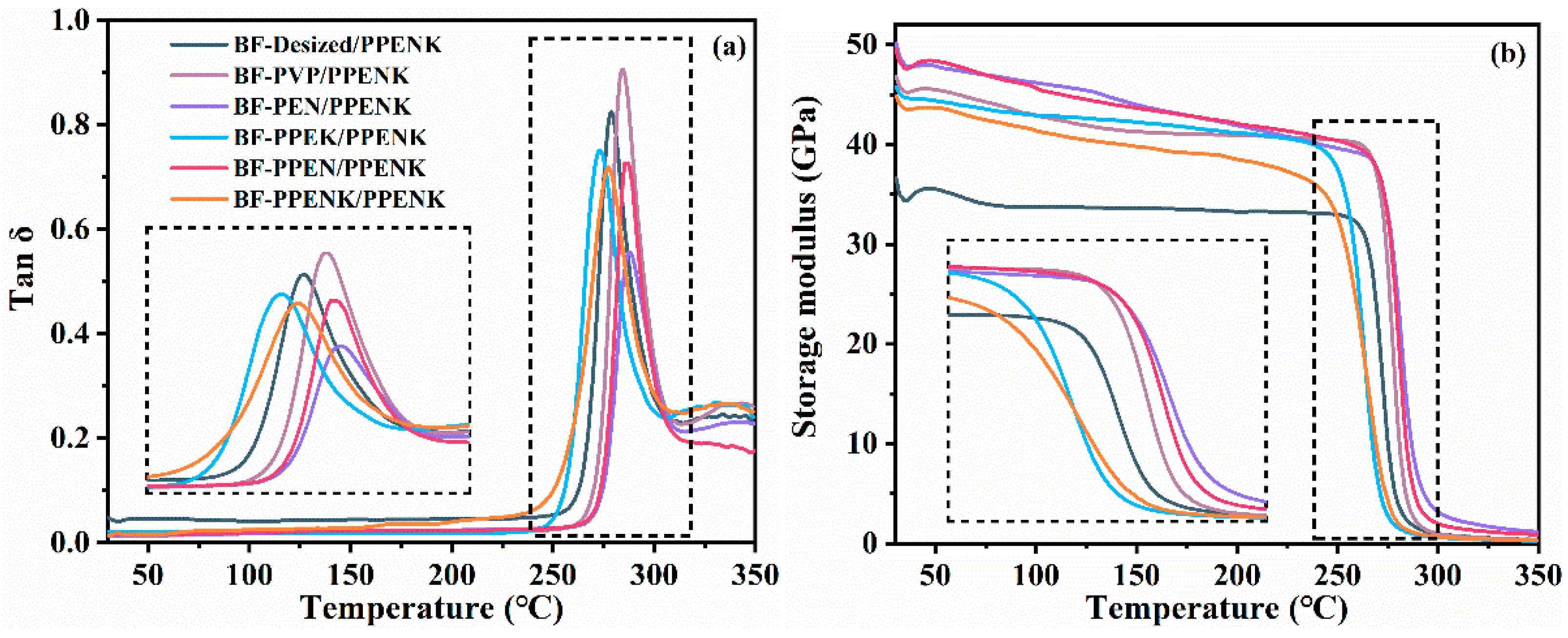
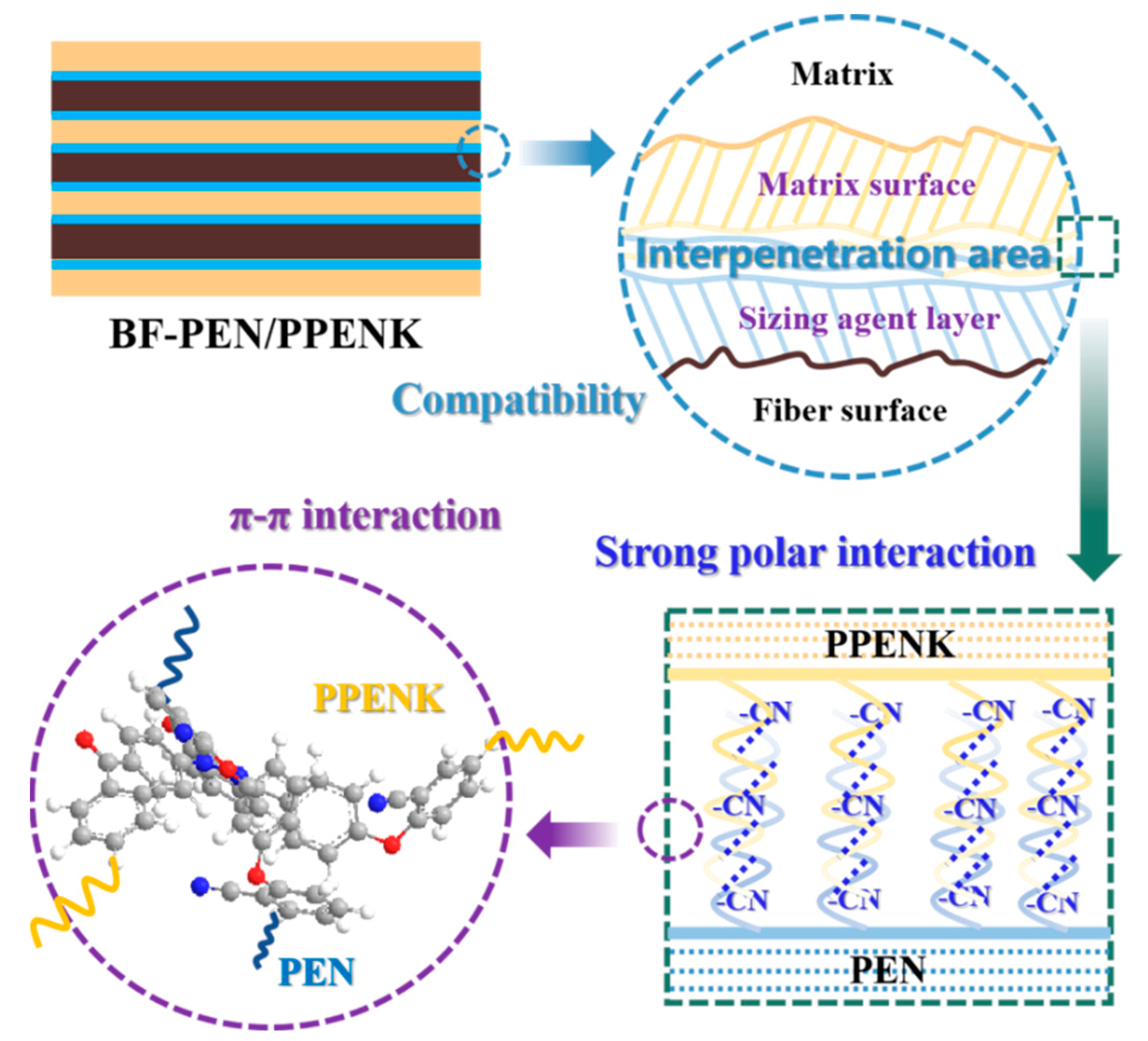
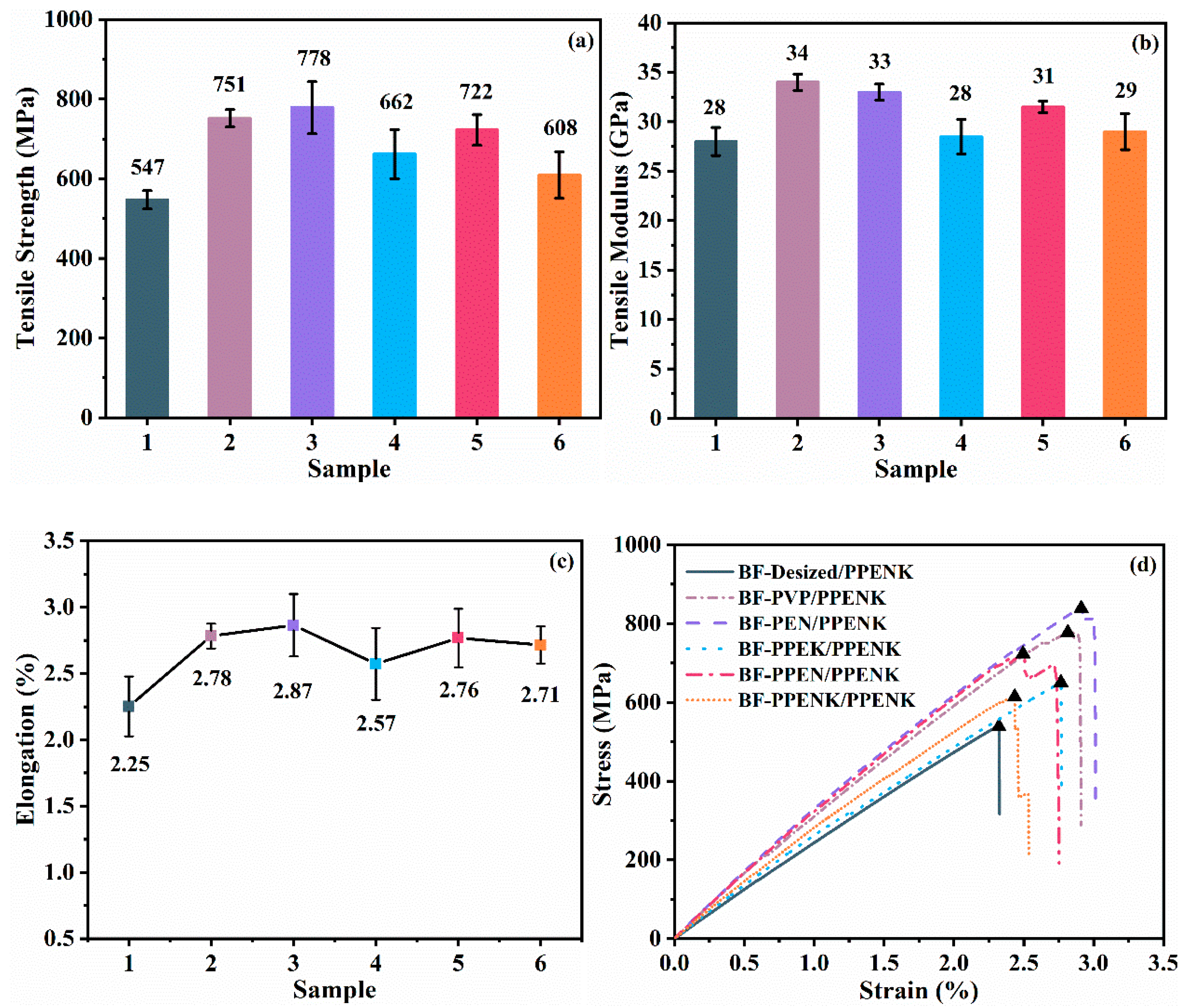
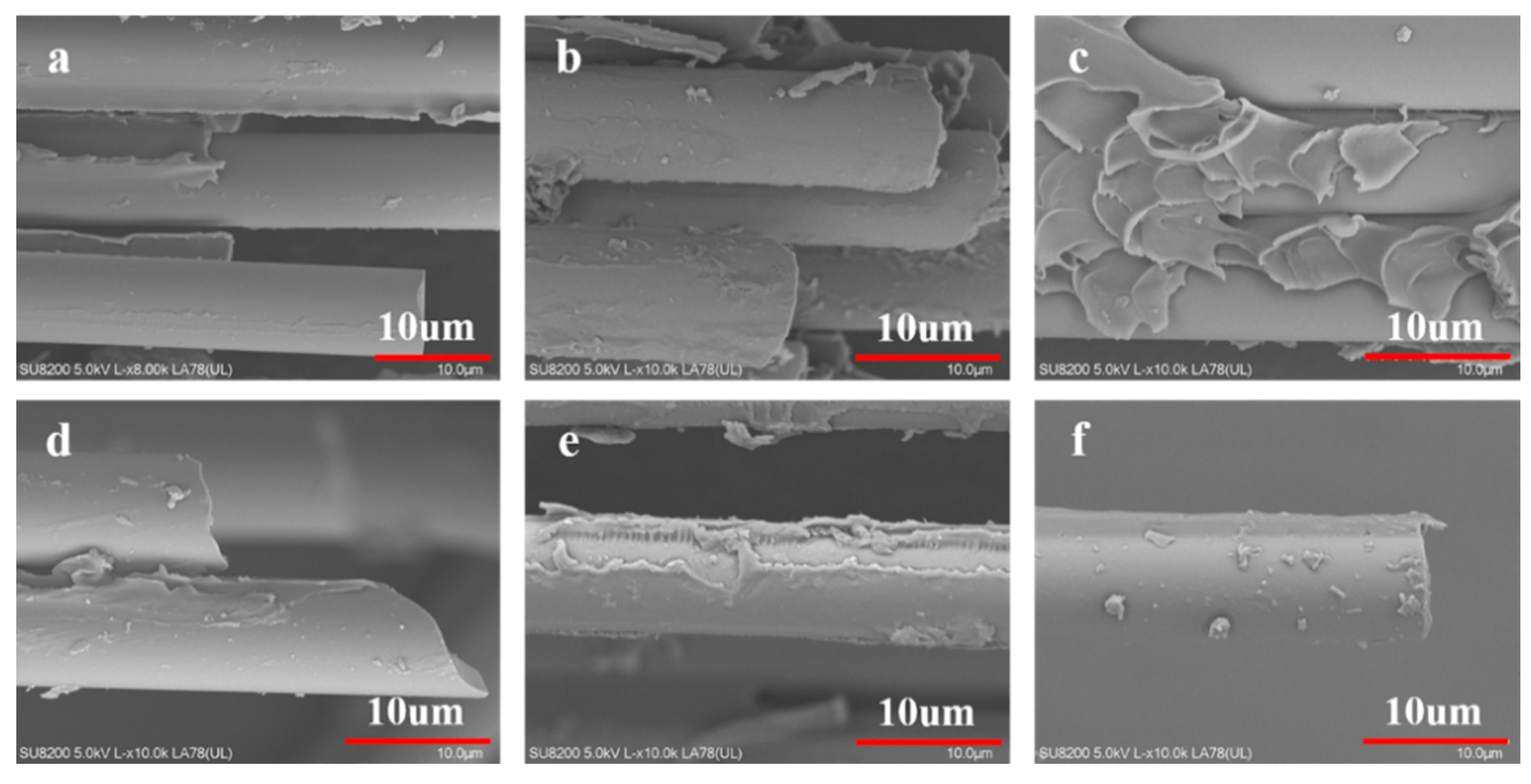

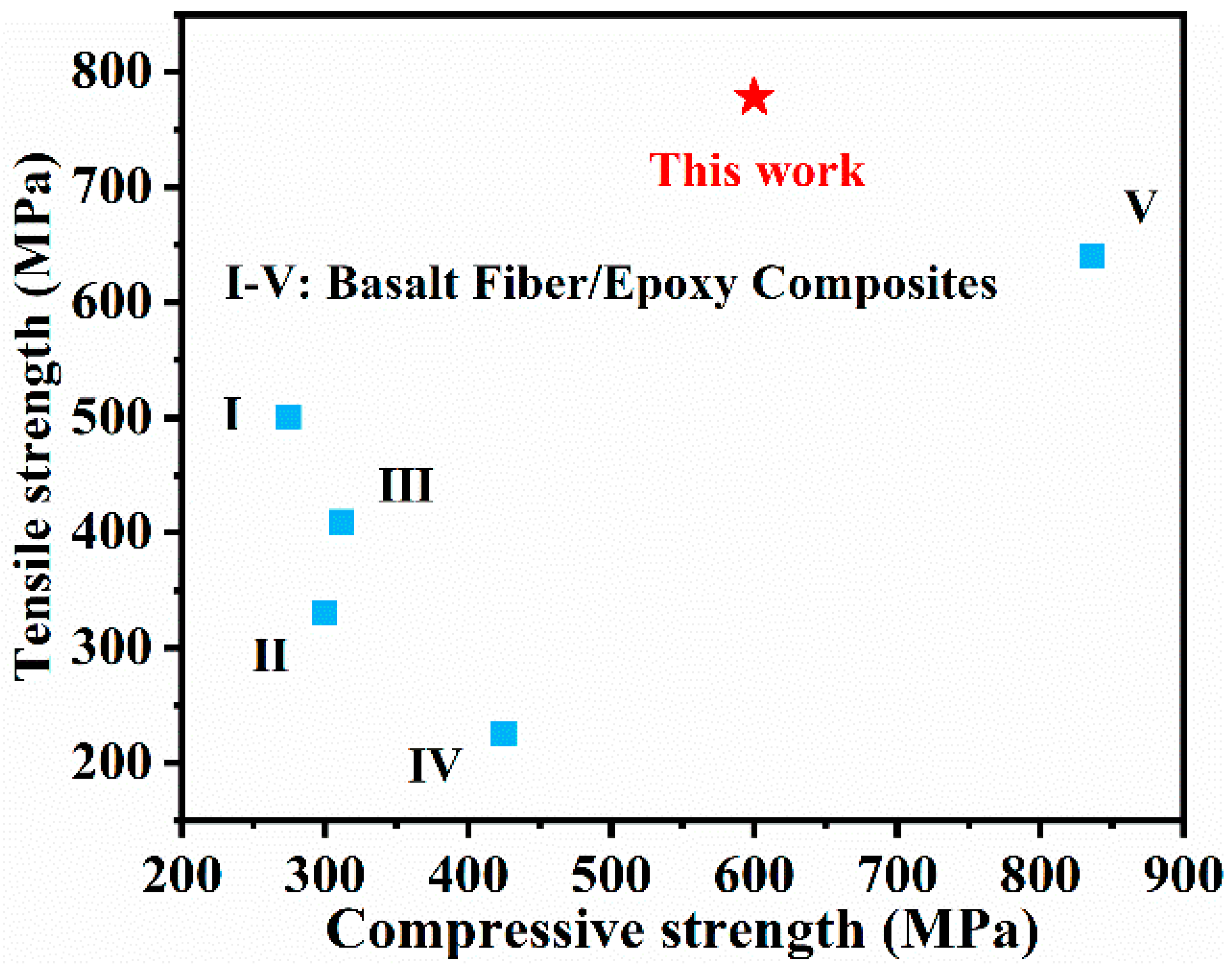
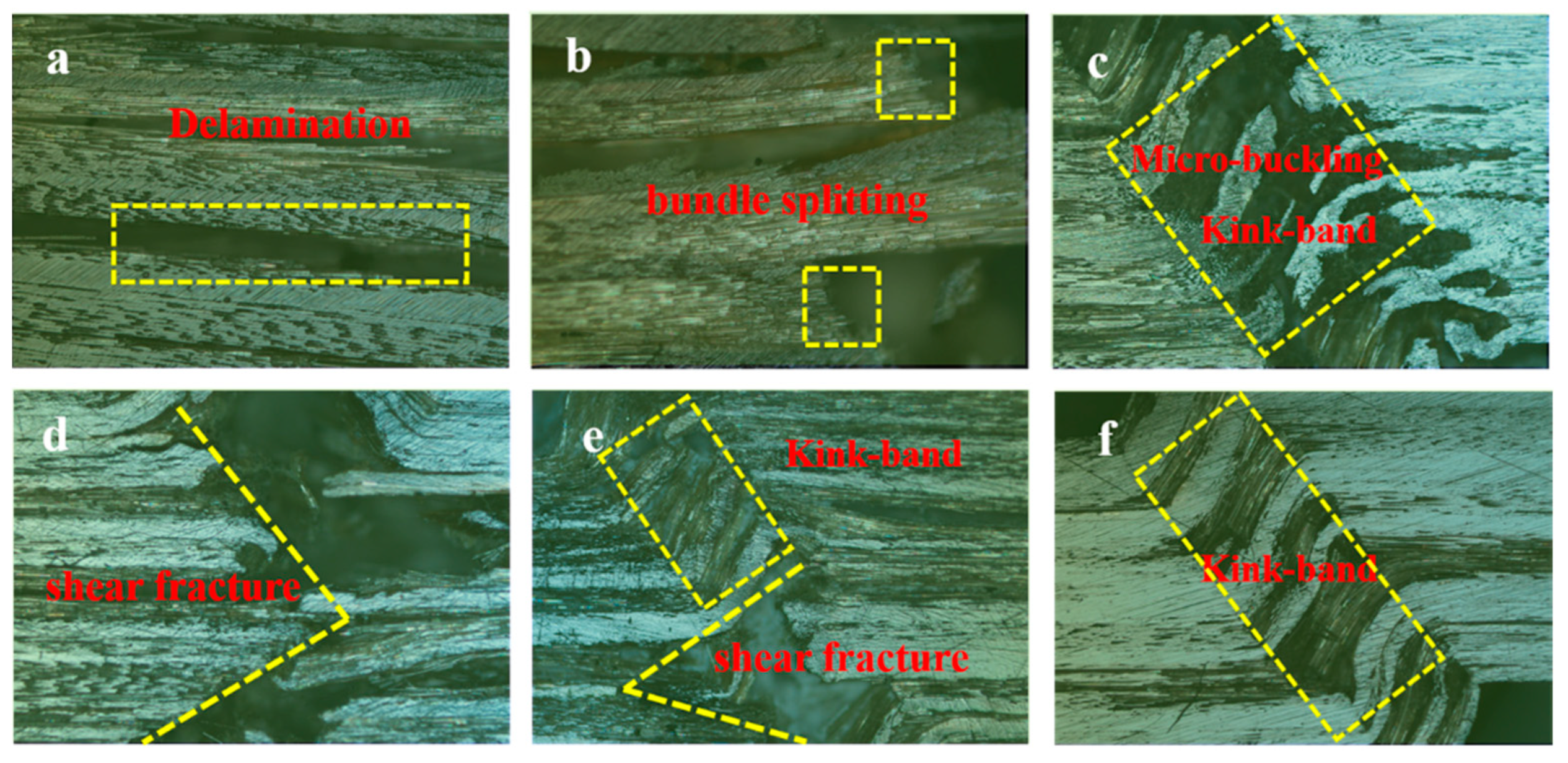
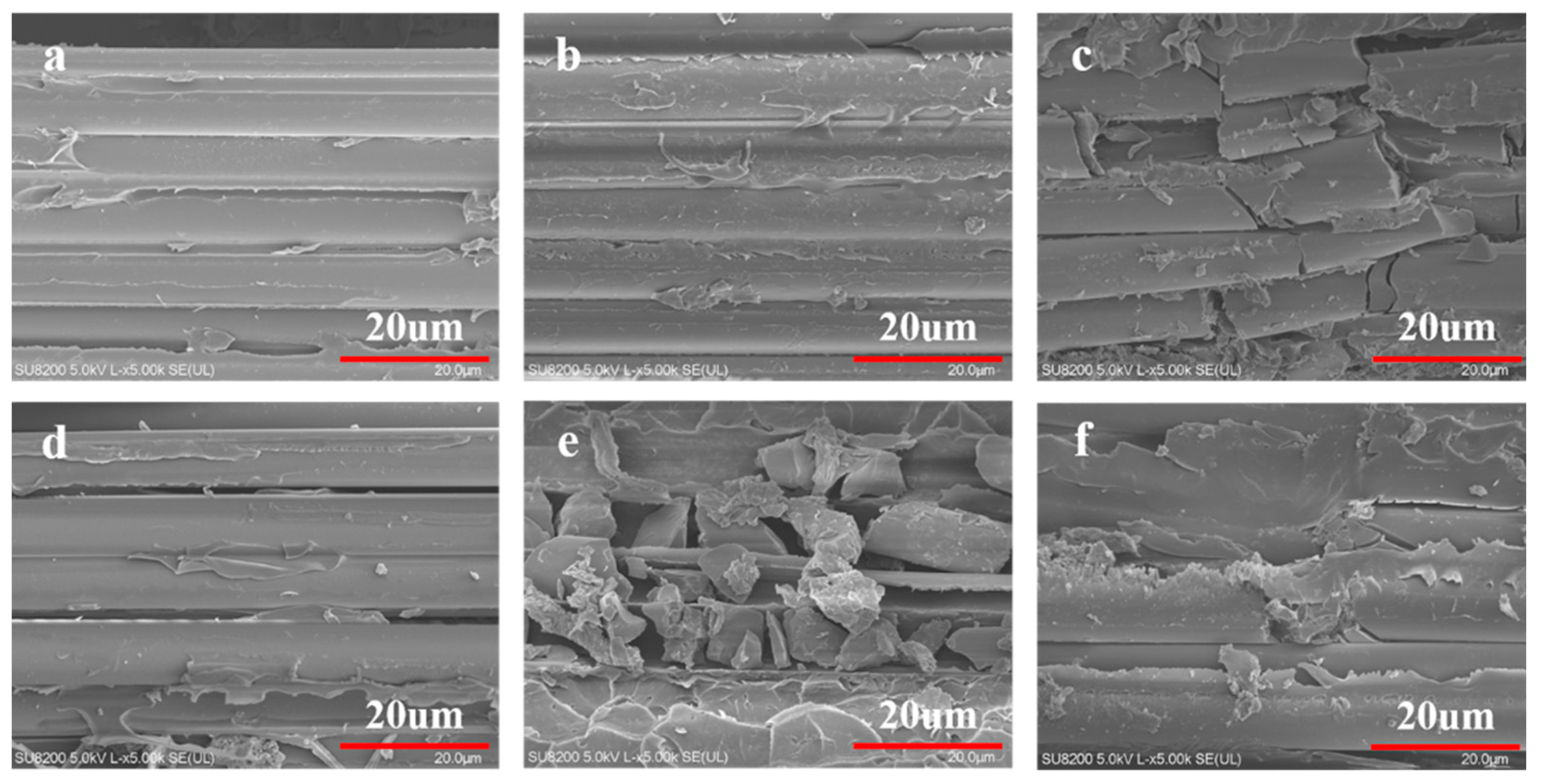
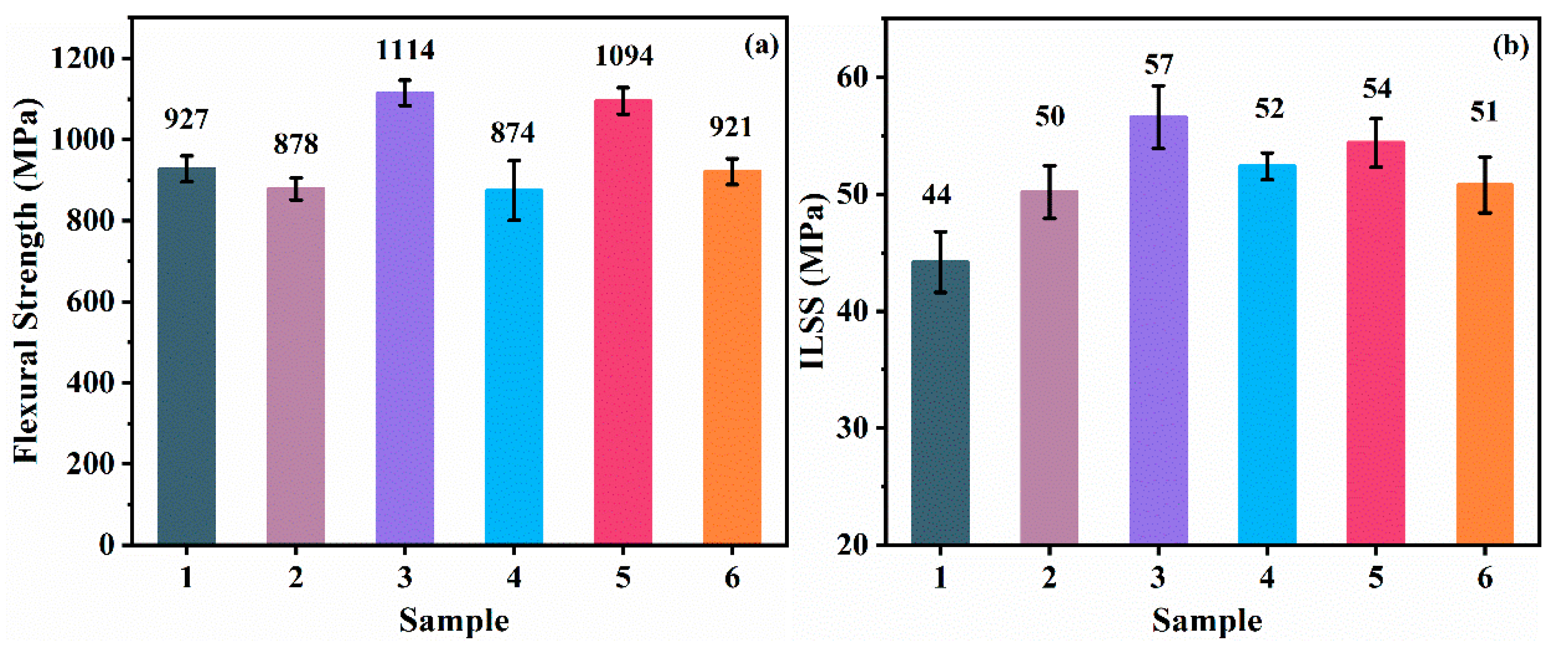
| Sample | δd | δp | δh | δt | |δt − δt,matrix| | |δp − δp,matrix| |
|---|---|---|---|---|---|---|
| PPEK | 19.51 | 5.02 | 6.83 | 21.27 | 0.26 | 0.8 |
| PPENK | 19.44 | 5.82 | 7.21 | 21.53 | 0 | 0 |
| PPEN | 19.35 | 6.77 | 7.65 | 21.88 | 0.35 | 0.95 |
| PVP | 16.98 | 11.35 | 8.46 | 22.11 | 0.58 | 5.53 |
| PEN | 19.82 | 7.16 | 5.62 | 21.81 | 0.28 | 1.34 |
Publisher’s Note: MDPI stays neutral with regard to jurisdictional claims in published maps and institutional affiliations. |
© 2022 by the authors. Licensee MDPI, Basel, Switzerland. This article is an open access article distributed under the terms and conditions of the Creative Commons Attribution (CC BY) license (https://creativecommons.org/licenses/by/4.0/).
Share and Cite
Jia, H.; Liu, C.; Qiao, Y.; Zhang, Y.; Fan, K.; Zhang, M.; Jian, X. Highly Enhancing the Interfacial and Mechanical Properties of Basalt Fiber/Poly(phthalazinone ether nitrile ketone) Composite by Thermoplastic Sizing Agents with Different Structures. Polymers 2022, 14, 2947. https://doi.org/10.3390/polym14142947
Jia H, Liu C, Qiao Y, Zhang Y, Fan K, Zhang M, Jian X. Highly Enhancing the Interfacial and Mechanical Properties of Basalt Fiber/Poly(phthalazinone ether nitrile ketone) Composite by Thermoplastic Sizing Agents with Different Structures. Polymers. 2022; 14(14):2947. https://doi.org/10.3390/polym14142947
Chicago/Turabian StyleJia, Hang, Cheng Liu, Yue Qiao, Yu Zhang, Kaiyuan Fan, Manxia Zhang, and Xigao Jian. 2022. "Highly Enhancing the Interfacial and Mechanical Properties of Basalt Fiber/Poly(phthalazinone ether nitrile ketone) Composite by Thermoplastic Sizing Agents with Different Structures" Polymers 14, no. 14: 2947. https://doi.org/10.3390/polym14142947






